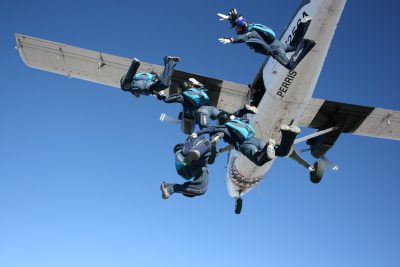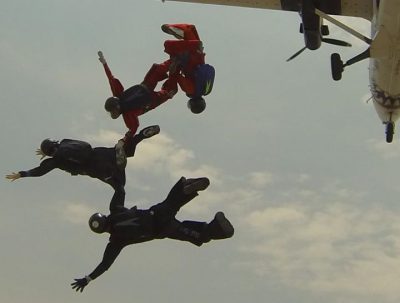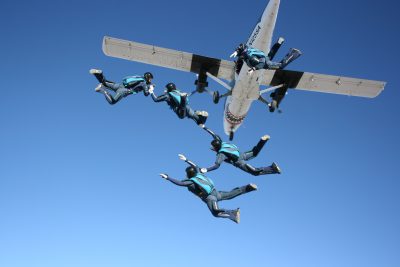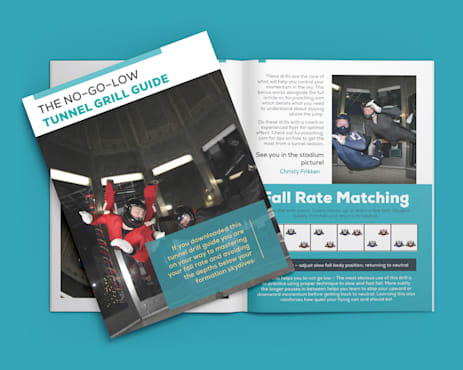Four Fundamental Linked Exit Principles
Thursday, October 10, 2019

- Christy Frikken
- 10/10/19
- 0
- Basic Flying Skills
The fun starts the second someone leaves the plane; so learn to leave the plane linked and start moving as soon as possible!
4 Core Principles
There are four major ideas you need to understand to leave linked with other people. Presentation, placement, timing, and fixing are the simple to understand mechanisms that teams use to start moving together right out the door. The principles are in order of importance too – so presentation rules them all!
Presentation
Of all three principles, presentation is the biggest key to success. If individuals are not faced into the wind with a correct body position when they leave, they can not properly fly. Mistakes in placement and timing can be corrected dynamically if jumpers can fly correctly.
Presentation is simply exiting in a good body position with your hips directly into the wind. On a video you will see your rig is presented directly to the camera. Lack of presentation causes a jumper to be “cut” into the wind or presenting their side to the relative wind.
The effect of being cut is easier to imagine by thinking of a formation at terminal velocity. Imagine while holding onto a star a jumper spontaneously rolls so that his side is downward. This has major adverse effects. At a minimum, the jumper is going to start a severe side slide. The jumper will also experience a fall rate change (faster) and drop away from the formation. This same dynamic applies instantly once skydivers are out the door.
In practical terms, if shortly after an exit you find yourself instantly low and away from the formation, you probably got cut into the wind.
Of course, rolling on your side is only one-way jumpers fail to present. Your body position matters as soon as you are not attached to the airplane. If your legs are all the way in, you will be flying backward. If your legs and arms are straight out, you will float. Sometimes these small tweaks are desirable to improve the formation – for example, the tail will often “pull” the formation downwards by flying backward to help stretch it the exit out. However, it is generally good practice to aim for a nice neutral position.
Placement
The second element of a good exit is placing yourself in a certain position on the wind. If four jumpers exited in the same place on the wind, they would burble each other and need to crawl off each other’s rigs. Everyone, therefore, is aiming to leave and move to a certain location at the door, giving space for everyone to fly.

Before leaving as a linked four-way, it is important to know where everyone is aiming to make the formation successful. It should be clear on the ground what the angle from the plane is for the whole formation (and thus the individuals within it). A great technique for quickly clarifying this is to “put your hands in,” where each hand represents where the skydiver intends to go.
Timing
Timing is crucial to a good exit. All individuals in a linked exit must leave together for the formation to be successful. To achieve leaving together a count is used to synchronize the team. There are loads of variations on exit timing which depend on the team, size of group, goals, training, etc. We will address a few common variations and their reasoning and then move on to universal advice.
Outside vs. inside
In 4-way teams will generally give the count to the outside center or the inside center (or a center person who is outside floating or inside diving).
Giving it to an outside person makes it more obvious for the videographer and may make some exits easier for beginner outside centers because it allows for a “leg swing”. Since the outside person’s movement and timing are crucial to an excellent exit, this sometimes helps. It may also disadvantage the outside center because she can only launch from a single leg. The outside center exit can be challenging; adding an extra element doesn’t make it easier.
Giving it to an inside person “hides” the count from the judges, which theoretically could extend the working time by a very tiny amount. The thinking is that judges watching a very clear outside count are more ready to hit “start” than those who must react after the exit. It also frees up the outside center to focus on balance and launching well.
Whole lotta shakin’ going on
Other variations are in the actual rhythm of the count and whether a shake is giving as a warning.
Options can include:
“shake shake – still pause – shake down out”
Inside center “shake shake”….outside center “out in out”
“shake-down-out”
“shake shake – out in out” (leg swing)
“out in out”
“nod out in out”
Counts boil down to personal preference in most cases. As long as the process is clear and consistent, almost any mechanic can work.
Fixing/Start Flying
You should start flying the instant you are in the wind. If the exit placement is not perfect, timing is off, or the formation is cut the exit can still be corrected. Correction requires all members of the team to see what needs to happen, understand how to fix it, and continually fly to where they are supposed to be.
An excellent example of this is rotation on the hill. Meekers launched from otters tend to have a vicious counter-clockwise spin. There are various placement and momentum issues that are the cause of this, but it can be corrected easily. As soon as everyone hits the air and feels the rotation, team members can make the inputs to rotate backward thus stopping the problem. The difference between teams doing this immediately and those who take two full turns on the hill is how quickly you can perceive the problem and apply the correct input.
If you are cut, get on the wind. If you see your clone is high, get big. If your placement is not high enough, fly there immediately.
The great news is that you don’t need every flyer to be completely perfect at all four of these skills to have a successful exit. If most of the people muster most of these you will a decent formation right out of the plane!
The best way to learn these principles is to try some 4way or 8way! If you are looking for a team, fill out a wish list or arrange another coached experience!
Tags: exit







